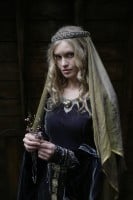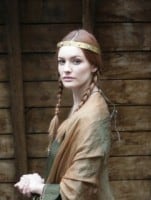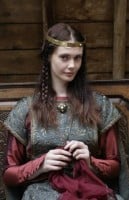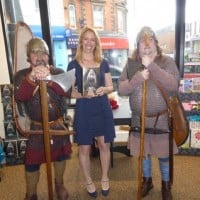The Queens of 1066
1066 is the most known date in English history and with good reason. It was a year of high drama, centring around a huge succession crisis, with battles all over the country, from up in York down to the south coast and it culminated in a mega-battle which was only won in the dying light of the day. It was the last year England was conquered and it had a huge impact on our history.
In terms of pure story, therefore, 1066 has a lot going for it and the main heroes are very well known. Who hasn’t heard of brave King Harold who died with an arrow in his eye trying to defend his country from invaders? Or the romantically named Harald Hardrada, a warrior feared throughout Europe but defeated by the English Harold’s heroic march north to York to surprise him? Or of William ‘the Bastard’ who brought his cavalry horses over the sea to tear up the English shield wall at Hastings and seize the throne? They are figures that feature in most people’s education somewhere along the line – but what of their queens?
History, especially from this far back, is dominated by men; this is not a feminist statement or even a complaint, just a fact. Just because they feature little in written record, however, does not mean that women did not wield significant influence in real life. All three of the 'heroes' of 1066's wives were significant women, powerful in their own right - so who were they?
 Edyth of Mercia, briefly wife of King Harold, was daughter of the irascible Earl Alfgar who frequently got himself into trouble at the royal court, including in 1055 when he somehow got himself exiled. He fled to the court of the sparkling and dangerous King Griffin, the only ever sovereign ruler of all Wales. He took a shine to Edyth so when her family returned to England, she remained in the wilds of Wales as his wife. She was just 14.
Edyth of Mercia, briefly wife of King Harold, was daughter of the irascible Earl Alfgar who frequently got himself into trouble at the royal court, including in 1055 when he somehow got himself exiled. He fled to the court of the sparkling and dangerous King Griffin, the only ever sovereign ruler of all Wales. He took a shine to Edyth so when her family returned to England, she remained in the wilds of Wales as his wife. She was just 14.
Whilst this was not an unusual age to marry at in these times it would be foolish of us to think it was easy for her and she had to grow up fast and learn about queenship the hard way. This experience, along with her bloodline (by 1066 her brothers were earls of Mercia and Northumbria), made her the perfect choice as wife for Harold, whose own family controlled the South. Edyth and Harold probably married at the end of 1065 and so she was Queen of England for the fateful nine months of his rule and was carrying his son and heir - later named Harold – when he tried to keep the invaders out of their country.
 Elizaveta of Kiev, wife to King Harald ‘Hardrada’ (Hard-ruler, or Ruthless) of Norway, was a princess of great influence. Her father, Grand Prince Yaroslav, was responsible for much of the rise in power and influence of the Rus lands in the first half of the eleventh century and his eleven children married into royal families throughout Europe. Elizaveta, probably his oldest daughter, met Harald when he was fleeing King Cnut’s conquest of Norway as a 15-year-old. He spent the next years selling his sword for treasure which Elizaveta kept for him in Rus vaults. He seems to have been genuinely in love with her – we have poetry apparently written by his hand bemoaning the way she scorned him – and finally won her hand in 1045. Theirs was a match of passion but also great power for they sailed to Norway together to reclaim the throne and by 1066 had ruled there for 20 years.
Elizaveta of Kiev, wife to King Harald ‘Hardrada’ (Hard-ruler, or Ruthless) of Norway, was a princess of great influence. Her father, Grand Prince Yaroslav, was responsible for much of the rise in power and influence of the Rus lands in the first half of the eleventh century and his eleven children married into royal families throughout Europe. Elizaveta, probably his oldest daughter, met Harald when he was fleeing King Cnut’s conquest of Norway as a 15-year-old. He spent the next years selling his sword for treasure which Elizaveta kept for him in Rus vaults. He seems to have been genuinely in love with her – we have poetry apparently written by his hand bemoaning the way she scorned him – and finally won her hand in 1045. Theirs was a match of passion but also great power for they sailed to Norway together to reclaim the throne and by 1066 had ruled there for 20 years.
Both Harald and Elizaveta were touching their fifties when they decided to invade England and Harald had a fearsome reputation as a warrior. They took a fleet of 300 ships and must have fancied their chances at the throne. Indeed, their first victory at Fulford was overwhelming and it was only a combination of their own overconfidence and English Harold’s heroism that led to defeat at Stamford Bridge. Elizaveta, never a woman to stay safely at home, was in the Orkneys with her daughters waiting to be called to the throne at her husband’s side. With sisters on the thrones of France and Hungary and her own power in Norway, we could have been a very different England had ‘Harald the Conqueror’ won the day.
Matilda of Flanders, wife of William of Normandy, was the eldest daughter o f Count Baldwin, a clever politician who used the position of his little county of Flanders, at the heart of trade routes between north and south Europe, to punch above his weight in central pol
f Count Baldwin, a clever politician who used the position of his little county of Flanders, at the heart of trade routes between north and south Europe, to punch above his weight in central pol
itics. A sharp operator he always had an eye to his own advantage and saw in William an ambitious and increasingly powerful young man who might one day make his daughter a queen.
Matilda was not, it seems, at all keen on the match at first but on meeting William she changed her mind. There are stories of a ‘rough wooing’ in which William dragged her down the street by her hair for refusing him, therby making her swoon at his manliness and swear undying love, but these are almost certainly products of an overindulgent thirteenth century imagination. Nonetheless something about the driven, determined, disciplined William must have convinced her he was good husband material and she was proved right. Together they ruled Normandy well, establishing a stable government that made the duchy the rich, secure and ambitious place from which they could launch their audacious invasion of England.
The Normans are traditionally cast as the ‘baddies’ in the 1066 story but to be fair to William and Matilda it seems that they were promised the throne by King Edward back in 1051 when they were newly wed and that, despite Edward going back on this promise, they clung to it as their right. And they weren’t alone. Their invasion was backed by the Pope himself and joined by thousands of men from all over northern France and in the end they won. Matilda, who was a direct descendant of Alfred the Great, became Queen of England. Her father was presumably very proud, though it was not a throne either she or William were ever truly allowed to be at ease upon.
What were these women like?
With the lack of source material it’s hard to truly say but we know enough to draw some basic conclusions. They would have been educated as generally speaking in this time men were trained to fight and women (rich ones), as well as being taught the traditional pursuits of needlework and household management, were given a formal, academic education. They would have been politically aware having been included in court life from an early age, not just for the niceties of social interaction but to further their families’ political aims and power. And, in an age of almost continual fighting of some sort, women at all levels of society would have been expected to hold their homes, be they a village shack or a castle, whilst their men were away at war. For high-born women this meant holding the reins of government and all our queens would have done so.
These three women fascinate me. It’s not that I don’t like the men as I’m a bit in love with all heroes, not that I feel any feminist outrage at their omission from history but simply that I am drawn by untold stories. It seems such a shame to me that, although we have all heard of Harold, Harald and William, very few of us know anything about the women who shared their lives, gave birth to their children, stood at their side on vital occasions and must surely have been their key confidants as they planned their bid for the throne of England. It is time the world knew more of them and I hope that my trilogy will allow that to happen.

